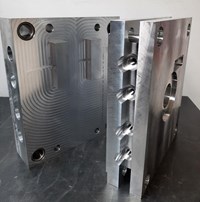Spring Cups Make Ejector System Installations Safer and Easier
Progressive Components’ Spring Cup ejector system component helps to prevent damage to ejector pins and components, while optimizing valuable space within a mold’s design.
Progressive Components’ Spring Cup ejector system component is designed to speed up and simplify the safe assembly of spring-loaded ejector systems, helping to prevent damage to ejector pins and components, and optimize valuable space within a mold’s design.
Because mold assembly can be cumbersome and unsafe when overcoming spring pressure within an ejector system, Spring Cups enable all ejection components to be installed first, without the ejector springs installed. This enables the ejector system to be tested or “dry cycled” to verify the mold components were assembled correctly and there are no binding issues, which can cause damage or premature wear to pins, sleeves and lifters. After verification, the mold’s springs are then installed and the Spring Cups bolted in last.
The Spring Cups accelerate the mold assembly process. Traditionally, a common requirement on a toolroom checklist is for the entire mold half to be assembled without springs, followed by a check that the ejector system is moving smoothly, then disassembly of the mold, springs added and then reassembled. However, when using Spring Cups, after verification of smooth ejection movement, assembly is completed — which means that a mold’s core half needs to only be assembled once. These steps are easily apparent to toolroom personnel, as Spring Cups feature laser-etched text with “Install last” and “Uninstall first.”
The company says that mold designs also benefit from the use of Spring Cups. It is common for springs to be located around a mold’s return pins, which then dictates the springs’ diameter to be large and for the length to often reach into valuable areas of the mold. Instead, when using Spring Cups, designers can select an application-suitable spring, one that is positioned to avoid prime areas of the mold to avoid waterlines, side actions and other features located in core plates. Because a proper spring compression amount can be selected, spring longevity and mold performance benefit.
An additional advantage for the mold’s design is that Spring Cups can also serve as a PKO Extension, enabling two functions to now be located at one location.
In addition to its use in ejection systems, Spring Cups can be used when splitting additional parting lines, such as for cavity-half side actions which open at the AX plate before the main parting line is opened.
Advantages for moldmakers include the fact that the springs are installed last, which enables verification of a smooth-running ejector system prior to spring installation. Assembly is safer by eliminating spring-loaded moving mold plates. An application-suited spring can be selected by designers and placed away from more valuable locations within the mold.
In addition, Spring Cups can be placed at PKO locations as a space-saving option. The Spring Cups can retain springs in other locations, such as cavity-half floating plates. They are available in seven sizes to accommodate common spring diameters and standard plate thicknesses.
CAD geometry is offered in various formats, including SolidWorks, NX, VISI, Parasolid, ACIS and IGES.
Related Content
-
Hands-on Workshop Teaches Mold Maintenance Process
Intensive workshop teaches the process of mold maintenance to help put an end to the firefighting culture of many toolrooms.
-
Moldmakers Deserve a Total Production Solution
Stability, spindle speed and software are essential consideration for your moldmaking machine tool.
-
How to Achieve the Best Mold Finish
A look at factors that impact the polishability of tool steels and recommendations for obtaining a high-gloss finish.

















